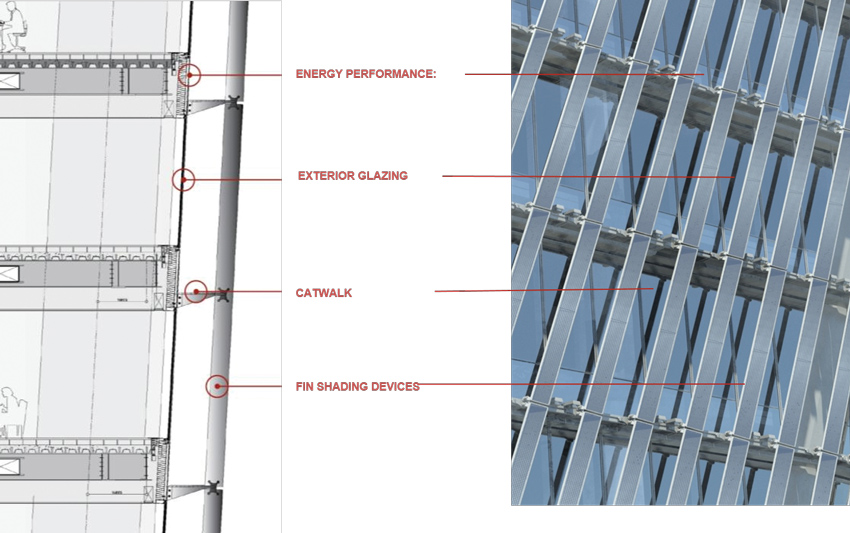Too Transparent?
THE NEED FOR GLASS
To the extent that the building codes are pushing higher energy standards, there is still a strong desire amongst owners, architects, and users for large amounts of natural light inside their buildings.
“Many architects and owners do still seek highly glazed building designs,” states Ring. “Fully glazed buildings can provide striking exterior elevations and dramatic first impressions on the interior.”
“Glass is critical and fundamental in the design of any building,” agrees Beene. “Glass shapes our spaces, can act as a defining design element, the natural light it creates shapes our moods, and the view provides a connection to the outside world beyond. These needs don’t go away just because we need to be more energy efficient, but it does challenge us as designers to question the amount of glass we use and balance the desire versus the need for glass.”
In terms of sorting through the technological solutions that can be employed to support a more expansive glass aesthetic, the first line of defense is usually high-performance glazing, for example, glass with a low U-factor and high solar heat gain shading coefficient, tinted and reflective glass, and triple-glazed insulated glass units.
Glass films, either laminated to the glass panes or suspended in between, have also become more available recently and significantly contribute to glass performance, adds Thomas Chinnock, AIA, an associate of Shepley Bulfinch in Phoenix, Arizona.
The Cleveland-based market research firm, The Freedonia Group, forecasts that U.S. demand for high-performance flat glass products will increase 8.2 percent annually through 2017.1
Meanwhile, the U.K-based Palmer Market Research group reports that commercial glazing posted a 29 percent rise in volume value growth from 2012 to 2014, and a further 20 percent rise in market value is anticipated out to 2019.2
Fortunately, high-performance glazing has advanced significantly over the past decade, and designers anticipate that new coatings and technologies will continue to emerge and advance, particularly in response to the trend toward energy efficiency. “It’s one of the most economical design tools we have in our toolbox to maintain significant glass exposure but maintain compliance with the energy codes,” remarks Beene.

Photo courtesy of Transsolar
At Loyola University’s Marcella Neihoff School of Nursing in Chicago, Illinois, designed by Solomen Cordwell Buenz, automatically controlled solar shades on the west facade and fixed louvers on the south facade are so effective that a thermally activated slab is capable of meeting all the cooling demand in the space.
Capitalizing on triple-silver technology—which applies three layers of silver during the magnetron sputter coating process, thereby delivering a high level of selectivity between light transmission and solar factor—the latest generation of low-e glazings are currently capable of delivering visible light transmittance levels above 50 percent with a solar heat gain coefficient below 0.25, which is a noted improvement in performance.
That said, Patterson offers a cautionary note against specifying an IGU with a low-e coating and calling it a day. “In spite of the significant gains achieved by the glass industry over past decades, especially in the area of solar glazings, even the high-performance glazings remain markedly poor thermal insulators, and solar control remains a problem,” he says.
Suggesting an alternative, Ring recommends unitized curtain wall systems with spandrel panels to present the exterior impression of a fully glazed building, while blocking much of the unnecessary thermal gains. He explains that often the best design choice is thoughtfully locating expansive glazing for the desired daylighting, views, and exterior impact, and using spandrel panels to improve thermal performance for the rest of the facade.
Meanwhile, Ring’s LPA colleague Rick D’Amato, AIA, LEED AP, principal, is witnessing an increase in alternative daylighting strategies, such as controlled skylights and tubular daylighting devices. “When possible, a thoughtful examination of the internal spaces has resulted in a ‘form follows function’ approach to facade design, which places and sizes glazing according to optimal use.”
In terms of solar shading systems, Ring says they can be highly effective in improving the thermal and daylighting performance of building envelopes, with the caveat that they must be designed correctly. The devices also require careful consideration to constructability and maintenance concerns.
Furthermore, their effectiveness is contingent upon climate, building orientation, and the location of the fenestration within the building, i.e. the number of stories and/or the depth of the floor plates. “Shading may provide significant benefit, or little to no benefit at all, depending on the design and location,” says Beene.

Image courtesy of HOK
At the 80-story Capital Market Authority Tower in Riyadh, Saudi Arabia, HOK specified fin-shading devices in an offset frit pattern, a triple-glazed IGU system, catwalk, and a photovoltaic array.
One of many examples where shades were successfully applied is Loyola University’s Marcella Neihoff School of Nursing in Chicago, Illinois, designed by Solomen Cordwell Buenz. According to Pratik Raval, associate director at Transsolar Inc. in New York, automatically controlled solar shades on the west facade and fixed louvers on the south facade help reduce solar loads to the point that a thermally activated slab can meet all of the cooling demand in the space.
Similarly, a high-profile international project—the HOK-designed Capital Market Authority Tower in Riyadh, Saudi Arabia—incorporates fin-shading devices in an offset frit pattern, along with a triple-glazed IGU system, catwalk, and a photovoltaic array at the top of the building’s 80-story crown. According to Roger Soto, AIA, LEED AP, design principal for HOK’s Gulf Coast region, the fins are optimized both in their plan position and sectional angle to account for the solar tracking, significantly reducing direct solar incidence from the harsh Middle Eastern sun on the conditioned enclosure.









